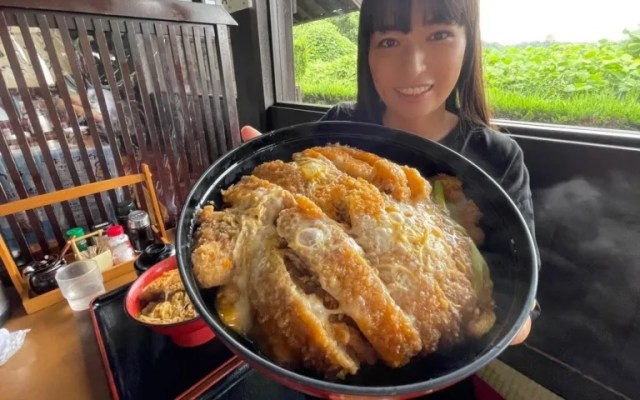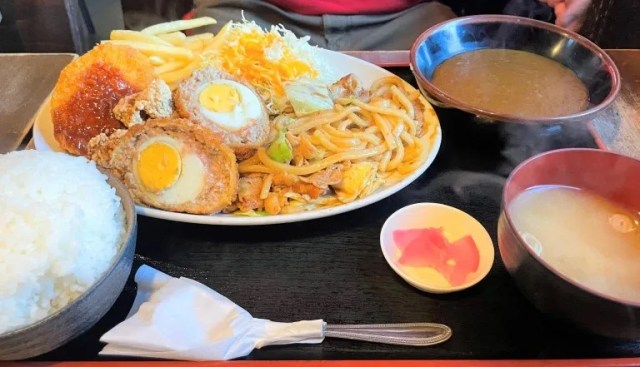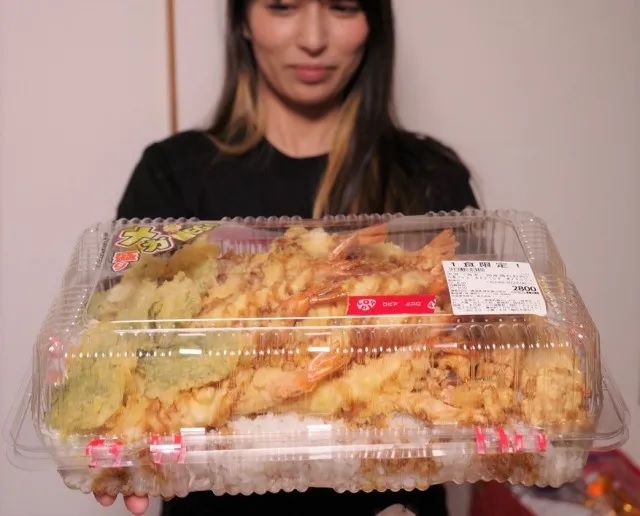
Ministry wants food in stomachs, not in the trash.
I once was eating lunch in a small cafe in Tokyo with a friend from overseas, who was full but had about half of the portion of roast pork he’d been served left over. When he asked the staff for a doggie bag to take the leftovers home in, he was informed that the restaurant couldn’t accommodate him, out of concern over the food potentially spoiling on his way home and causing him to get food poisoning if he then ate it. This isn’t an unusual stance for restaurants in Japan to take, either. Though the country has a rich dining culture, characterized by attention to thoughtful hospitality, restaurants in Japan generally don’t provide doggie bags.
In the end, my friend surreptitiously slipped his leftover hunk of meat into a plastic bag he happened to have on him, which he then stuffed inside of his shoulder bag and smuggled out of the restaurant. Such duplicity might soon become unnecessary, though, thanks to a new initiative from Japan’s Ministry of Health, Labor and Welfare.
A recently concluded study found that in 2022, Japan had roughly 4,720,000 metric tons of food waste, roughly half of which came from restaurants and food shops. In order to reduce those numbers, the government is looking to promote the use of doggie bags, so that instead of going into the trash, diners’ food that they don’t finish at the restaurant will go into their refrigerators, and later their stomachs.
Last week, the Ministry of Health, Labor and Welfare held its first meeting of a newly formed investigative committee on the subject, with members of the ministry convening with university researchers and consumer advocacy groups. Their goal is to put together a set of guidelines which can then be presented to restaurants, izakaya (Japanese-style pubs), hotels, and other dining establishments covering topics about which foods are and aren’t safe to allow customers to take home leftovers of, who should package the leftovers and in what ways, and a notification framework in the event of someone contracting food poisoning after consuming the contents of a doggie bag. Another key point of the discussions so far is communicating that even for foods that are doggie bag-permissible under the eventual guidelines, the final responsibility for determining whether the leftovers are safe to eat or not lies with the customer, not the restaurant.
In theory, establishing safety guidelines doesn’t seem like it should be terribly difficult. It’s not like food poisoning is rampant in countries where taking home restaurant leftovers is common. Even within Japan, there are plenty of restaurants that offer to-go orders, not to mention tons of bakeries, bento shops, and food stands selling everything from grilled chicken to roasted sweet potatoes on a to-go-only basis. It’s hard to believe that the 30 minutes or so that restaurant leftovers might have been on a customer’s plate mean that the food has crossed a threshold beyond which it’ll be unfit for human consumption by the time it gets home. And if the customer doesn’t go straight home? That’s the same risk as with any other buy-it-here, eat-it-somewhere-else scenarios, and it’s not like there’s an epidemic of people in Japan collapsing at home after eating fried chicken they picked up at the convenience store.
▼ If Japanese supermarkets can let us take home prepared food like this, restaurant doggie bags aren’t an impossibility.
It’s possible that the bigger challenge to getting restaurants in Japan to proactively provide doggie bags won’t be health/hygiene-based, but instead one of image and operations management. It seems pretty clear that if they’d wanted to, restaurants in Japan could have started providing doggie bags long ago, seeing as how takeout and grab-and-go restaurants have flourished in Japan. So it’s at least a little likely that “We can’t provide doggie bags for health reasons” actually has more to do with not wanting to make a sit-down restaurant look like a cheap takeout joint, or not wanting to pull workers off of preparing and serving new orders to have them package up something that’s no longer bringing in any additional revenue for the restaurant.
The Ministry of Health, Labor and Welfare hopes to have its doggie bag guidelines finalized and available to restaurants sometime this year.
Source: NHK News Web
Photos ©SoraNews24
● Want to hear about SoraNews24’s latest articles as soon as they’re published? Follow us on Facebook and Twitter!



 Japanese restaurant chain starts bold new policy: Letting you take your leftovers home with you
Japanese restaurant chain starts bold new policy: Letting you take your leftovers home with you Japan’s biggest family restaurant chain now lets you take your leftovers home with you
Japan’s biggest family restaurant chain now lets you take your leftovers home with you Japanese government seeking power to turn down private home air conditioners remotely, report says
Japanese government seeking power to turn down private home air conditioners remotely, report says 50 centimetres (20 inches) of unbridled beefy joy! Eating Tokyo’s extra-lengthy yukhoe sushi
50 centimetres (20 inches) of unbridled beefy joy! Eating Tokyo’s extra-lengthy yukhoe sushi Popular Japanese ramen restaurant Ichiran’s lucky bags are great value for money
Popular Japanese ramen restaurant Ichiran’s lucky bags are great value for money Starbucks Japan releases new drinkware and goods for Valentine’s Day
Starbucks Japan releases new drinkware and goods for Valentine’s Day Japan’s foreign tourist numbers projected to fall for first time in years in 2026
Japan’s foreign tourist numbers projected to fall for first time in years in 2026 Immersive ukiyoe exhibition in Osaka adds some scented flair
Immersive ukiyoe exhibition in Osaka adds some scented flair McDonald’s Japan releases a Mushroom Mountain and Bamboo Shoot Village McFlurry
McDonald’s Japan releases a Mushroom Mountain and Bamboo Shoot Village McFlurry Village Vanguard’s Blue Lucky Bag may have the most impressive piece of junk ever created
Village Vanguard’s Blue Lucky Bag may have the most impressive piece of junk ever created Totoro cream puffs and Catbus cookies are finally available in downtown Tokyo
Totoro cream puffs and Catbus cookies are finally available in downtown Tokyo Japan’s otoshidama tradition of giving kids money at New Year’s gets a social welfare upgrade
Japan’s otoshidama tradition of giving kids money at New Year’s gets a social welfare upgrade Young Japanese adults show lowest dating experience level yet in annual survey
Young Japanese adults show lowest dating experience level yet in annual survey Big win for tattoo artists: Japan’s Supreme Court rules medical licenses aren’t necessary
Big win for tattoo artists: Japan’s Supreme Court rules medical licenses aren’t necessary Hachiji juppun mae – A Japanese phrase that even Japanese people can’t agree on the meaning of
Hachiji juppun mae – A Japanese phrase that even Japanese people can’t agree on the meaning of 10 times to avoid traveling in Japan in 2026
10 times to avoid traveling in Japan in 2026 Our 52-year-old pole dancing reporter shares his tips for achieving your New Year’s exercise goal
Our 52-year-old pole dancing reporter shares his tips for achieving your New Year’s exercise goal Starbucks Japan releases new Frappuccino and latte for Valentine’s Day
Starbucks Japan releases new Frappuccino and latte for Valentine’s Day Ramen restaurant’s English menu prices are nearly double its Japanese ones, denies discriminating
Ramen restaurant’s English menu prices are nearly double its Japanese ones, denies discriminating Princess Mononoke magnets return just in time to treat yourself to awesome anime decorations
Princess Mononoke magnets return just in time to treat yourself to awesome anime decorations Umamusume anime girl plushie recalled for having parts she absolutely should not have【Pics】
Umamusume anime girl plushie recalled for having parts she absolutely should not have【Pics】 Giant hotel rooms in Osaka reflect the new non-niche face of travel in Japan.
Giant hotel rooms in Osaka reflect the new non-niche face of travel in Japan. Japanese women showing rebounding interest in giving Valentine’s Day chocolate【Survey】
Japanese women showing rebounding interest in giving Valentine’s Day chocolate【Survey】 We ate sushi made from Japan’s most expensive tuna ever【Taste test】
We ate sushi made from Japan’s most expensive tuna ever【Taste test】 Starbucks Japan ready to get Year of the Horse started with adorable drinkware and plushies【Pics】
Starbucks Japan ready to get Year of the Horse started with adorable drinkware and plushies【Pics】 7-Eleven Japan starts new temporary luggage storage service in over 300 branches
7-Eleven Japan starts new temporary luggage storage service in over 300 branches Disillusionment at Tsukiji’s tourist-target prices led us to a great ramen restaurant in Tokyo
Disillusionment at Tsukiji’s tourist-target prices led us to a great ramen restaurant in Tokyo Starbucks teams up with 166-year-old Kyoto doll maker for Year of the Horse decorations【Photos】
Starbucks teams up with 166-year-old Kyoto doll maker for Year of the Horse decorations【Photos】 Tokyo’s Tsukiji sushi neighborhood asks tour groups to stay away for the rest of the month
Tokyo’s Tsukiji sushi neighborhood asks tour groups to stay away for the rest of the month Survey asks foreign tourists what bothered them in Japan, more than half gave same answer
Survey asks foreign tourists what bothered them in Japan, more than half gave same answer Japan’s human washing machines will go on sale to general public, demos to be held in Tokyo
Japan’s human washing machines will go on sale to general public, demos to be held in Tokyo We deeply regret going into this tunnel on our walk in the mountains of Japan
We deeply regret going into this tunnel on our walk in the mountains of Japan Studio Ghibli releases Kodama forest spirits from Princess Mononoke to light up your home
Studio Ghibli releases Kodama forest spirits from Princess Mononoke to light up your home Major Japanese hotel chain says reservations via overseas booking sites may not be valid
Major Japanese hotel chain says reservations via overseas booking sites may not be valid Put sesame oil in your coffee? Japanese maker says it’s the best way to start your day【Taste test】
Put sesame oil in your coffee? Japanese maker says it’s the best way to start your day【Taste test】 No more using real katana for tourism activities, Japan’s National Police Agency says
No more using real katana for tourism activities, Japan’s National Police Agency says Starbucks Japan reveals new sakura drinkware collection, inspired by evening cherry blossoms
Starbucks Japan reveals new sakura drinkware collection, inspired by evening cherry blossoms Updated cherry blossom forecast shows extra-long sakura season for Japan this year
Updated cherry blossom forecast shows extra-long sakura season for Japan this year Hey, Japanese taxi driver! Take us to a great restaurant in Utsunomiya
Hey, Japanese taxi driver! Take us to a great restaurant in Utsunomiya
Leave a Reply